The 1920s
Although all courses in psychology were taught by professors of metaphysics or philosophy since the first psychology course was taught at WVU, except for Professor Scripture’s summer classes, all changed in 1921 with the hiring of John E. Winter, PhD, as Assistant Professor of Psychology. Professor Winter obtained his doctorate from the University of Michigan in experimental psychology studying under Walter Pillsbury, the 19th President of the American Psychological Association. During his initial years at WVU, he split instructional responsibilities with Professor Charles Cantrall, with his colleague covering all philosophy courses and Professor Winter covering courses in experimental, social, comparative, genetic, applied, and abnormal psychology as well as history of psychology. To establish his program of research, Professor Winter was allocated two rooms in the library (presently Stewart Hall) for a laboratory devoted to the study of experimental psychology.
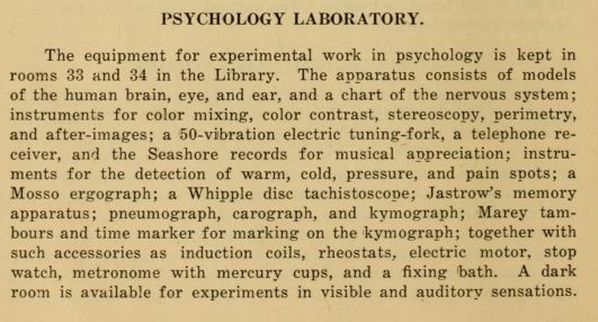
Description of Professor Winter’s Psychology Laboratory from the 1922-23 WVU Catalog
Reflecting the balanced offerings of psychology and philosophy courses that could be offered now that the university had a full-time psychologist, the unit was renamed the Department of Philosophy and Psychology in 1923. To assist in covering the expanded course offerings in psychology, the university recruited Elizabeth Mattingly Stalnaker, PhD, to return to her alma mater following completion of her doctorate at Johns Hopkins University in 1924. She was initially appointed to the faculty in the Department of Education due to her interests in child development and learning but moved into the Department of Philosophy and Psychology in 1927 when the College of Education parted from the College of Arts and Sciences.
With two psychologists on faculty, increased demand for their courses occurred, resulting in the naming of student assistants to help in teaching the laboratory courses and the occasional offering of psychology courses by visiting faculty members. Elizabeth Jane Cox, the first psychology student assistant in 1924, earned her bachelor’s degree from WVU the following year. Professor Winter became chairperson and the department began to offer separate majors in philosophy and psychology in 1929. Requirements for a major in psychology included completion of 25 hours of coursework in the department with at least one course in philosophy. Professor Winter is also credited with publishing the first journal article by a psychologist at WVU. The paper was entitled “The psychology of freshman rules” and was published in the journal, School & Society, in 1927. In this paper, Professor Winter identified several rules responsible for class conflict and maladjustment among the entering freshman classes by surveying rules of conduct and dress at 42 peer institutions.
The 1930s
Under new leadership in the 1930s, the mission of the university was extended beyond being an institution focused on undergraduate education. This was not a simple task, given that the country was in the midst of the Great Depression and financial means to attend college for many were lacking. Nevertheless, the university persisted in these efforts and the faculty responded favorably to this direction. Acknowledging this emphasis on scholarship, Professor Winter published results of several experiments, one of which described the use of the polygraph for detecting lying among college women following several thefts that had occurred in a dormitory at WVU (Journal of Applied Psychology, 1936, 20, 243-248).
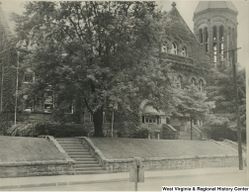 The Department had outgrown its space in Woodburn Hall and was relocated across University
Avenue to the third floor of the Old Library (later named Stewart Hall) when the
New Library was opened in 1931. The remainder of the Old Library was occupied by
the University Demonstration High School while they awaited construction of their
new facility at the top of the hill (later to become University High School and now Mountaineer Middle School).
The Department had outgrown its space in Woodburn Hall and was relocated across University
Avenue to the third floor of the Old Library (later named Stewart Hall) when the
New Library was opened in 1931. The remainder of the Old Library was occupied by
the University Demonstration High School while they awaited construction of their
new facility at the top of the hill (later to become University High School and now Mountaineer Middle School).
Recognizing the importance of the land grant mission of the institution, the Department engaged in many outreach efforts, including the development of the first nursery school in Monongalia County, staffed by Professor Stalnaker’s child psychology class.
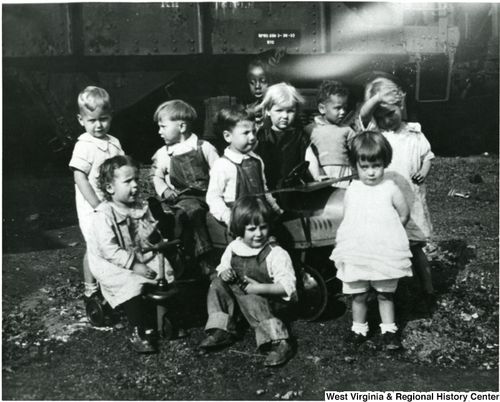
Children at the first Child Nutrition Nursery School in Monongalia County (1932)
In 1929, the Department of Philosophy and Psychology began recruiting students to complete graduate coursework, and Wiley Scott Garrett, from Fairmont, WV, was the first student to enroll in 1930. He completed a thesis project, entitled "A comparison of the incidence of introversion, extraversion, and emotional instability (psychasthenoid, neurasthenoid, and schizophrenoid) in university and high school students” and was the first recipient of a graduate degree (Master of Arts) in psychology from WVU in 1932. Mary Nicodemus Goff was the first woman to earn an advanced degree in psychology at WVU in 1942.
Although the exact date the Department of Philosophy and Psychology was relocated back to Woodburn Hall is unknown, it is likely to have occurred during the latter years of this decade. The Old Library was referred to as the Administration Building before 1940, a function it maintains to this day.
The 1940s
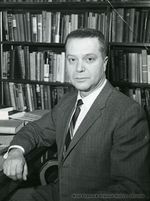 In 1941, Quin Fischer Curtis, PhD, joined the Department of Philosophy and Psychology
as Assistant Professor of Psychology following receipt of his doctorate in experimental
psychology from the University of Michigan, and
completion of post-doctoral work at Cornell University under the direction of
Howard Liddell, an influential comparative psychologist. In addition to the newly hired Curtis,
seen here, the department faculty in the 1940s consisted of Psychology Professors
Winter and Stalnaker and Philosophy Professor John Cresswell. The three psychologists
shared teaching responsibilities, with Professors Winter and Curtis instructing courses
in experimental psychology and Professor Stalnaker instructing the more applied courses.
In 1941, Quin Fischer Curtis, PhD, joined the Department of Philosophy and Psychology
as Assistant Professor of Psychology following receipt of his doctorate in experimental
psychology from the University of Michigan, and
completion of post-doctoral work at Cornell University under the direction of
Howard Liddell, an influential comparative psychologist. In addition to the newly hired Curtis,
seen here, the department faculty in the 1940s consisted of Psychology Professors
Winter and Stalnaker and Philosophy Professor John Cresswell. The three psychologists
shared teaching responsibilities, with Professors Winter and Curtis instructing courses
in experimental psychology and Professor Stalnaker instructing the more applied courses.
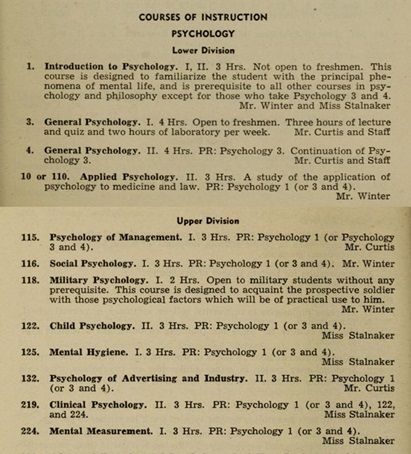
Psychology courses offered in 1944-45 from the WVU Catalog
Dr. Curtis was promoted to the rank of Professor in 1948 and appointed Acting Department Head when Professor Winter retired and was granted emeritus status that year. Two new Assistant Professors of Psychology were hired to help cover instructional responsibilities upon the retirement of Professor Winter: John Chalmer Townsend, PhD, from the University of Pittsburgh, and Kennon F. McCormick, AM, from the Ohio State University. Also, in November of 1948, the department founded its chapter of Psi Chi, psychology’s national honorary, and several top students were inducted. To conclude the decade, Professor Curtis was appointed department chair in 1949, a position he held until 1968.
A great need for applied psychologists was recognized as the nation was fully engaged in World War II. Initially applying psychological assessments of intelligence and aptitude to assist the armed services in matching soldiers to optimal work or military assignments, these expert assessors began to be consulted for treating soldiers who experienced psychological problems like “battle fatigue” and treating veterans upon returning home at the end of the war. Although many psychologists were hired and employed by the Veterans Administration (VA) hospitals in the 1940s, few had received formal training as clinical psychologists. To remedy the lack of qualified psychologists, the VA created a section of Clinical Psychology in the Division of Neuropsychiatry in 1946 and launched programs to train doctoral graduate students in the application of clinical psychology shortly thereafter. In 1949, the historic Boulder Conference was held that outlined the foundations of the scientist-practitioner model of training that provided the structure for academic training programs to develop doctoral programs in clinical psychology. This conference had no immediate influence on the psychology program at WVU, because it had only 6 MA degrees to its credit by 1949 and did not yet have a doctoral program, nor were any faculty members trained in clinical psychology.
< History HOME NEXT History Page >
Although all courses in psychology were taught by professors of metaphysics or philosophy since the first psychology course was taught at WVU, except for Professor Scripture’s summer classes, all changed in 1921 with the hiring of John E. Winter, PhD, as Assistant Professor of Psychology. Professor Winter obtained his doctorate from the University of Michigan in experimental psychology studying under Walter Pillsbury, the 19th President of the American Psychological Association. During his initial years at WVU, he split instructional responsibilities with Professor Charles Cantrall, with his colleague covering all philosophy courses and Professor Winter covering courses in experimental, social, comparative, genetic, applied, and abnormal psychology as well as history of psychology. To establish his program of research, Professor Winter was allocated two rooms in the library (presently Stewart Hall) for a laboratory devoted to the study of experimental psychology.
Description of Professor Winter’s Psychology Laboratory from the 1922-23 WVU Catalog
Reflecting the balanced offerings of psychology and philosophy courses that could be offered now that the university had a full-time psychologist, the unit was renamed the Department of Philosophy and Psychology in 1923. To assist in covering the expanded course offerings in psychology, the university recruited Elizabeth Mattingly Stalnaker, PhD, to return to her alma mater following completion of her doctorate at Johns Hopkins University in 1924. She was initially appointed to the faculty in the Department of Education due to her interests in child development and learning but moved into the Department of Philosophy and Psychology in 1927 when the College of Education parted from the College of Arts and Sciences.
With two psychologists on faculty, increased demand for their courses occurred, resulting in the naming of student assistants to help in teaching the laboratory courses and the occasional offering of psychology courses by visiting faculty members. Elizabeth Jane Cox, the first psychology student assistant in 1924, earned her bachelor’s degree from WVU the following year. Professor Winter became chairperson and the department began to offer separate majors in philosophy and psychology in 1929. Requirements for a major in psychology included completion of 25 hours of coursework in the department with at least one course in philosophy. Professor Winter is also credited with publishing the first journal article by a psychologist at WVU. The paper was entitled “The psychology of freshman rules” and was published in the journal, School & Society, in 1927. In this paper, Professor Winter identified several rules responsible for class conflict and maladjustment among the entering freshman classes by surveying rules of conduct and dress at 42 peer institutions.
The 1930s
Under new leadership in the 1930s, the mission of the university was extended beyond being an institution focused on undergraduate education. This was not a simple task, given that the country was in the midst of the Great Depression and financial means to attend college for many were lacking. Nevertheless, the university persisted in these efforts and the faculty responded favorably to this direction. Acknowledging this emphasis on scholarship, Professor Winter published results of several experiments, one of which described the use of the polygraph for detecting lying among college women following several thefts that had occurred in a dormitory at WVU (Journal of Applied Psychology, 1936, 20, 243-248).
Recognizing the importance of the land grant mission of the institution, the Department engaged in many outreach efforts, including the development of the first nursery school in Monongalia County, staffed by Professor Stalnaker’s child psychology class.
Children at the first Child Nutrition Nursery School in Monongalia County (1932)
In 1929, the Department of Philosophy and Psychology began recruiting students to complete graduate coursework, and Wiley Scott Garrett, from Fairmont, WV, was the first student to enroll in 1930. He completed a thesis project, entitled "A comparison of the incidence of introversion, extraversion, and emotional instability (psychasthenoid, neurasthenoid, and schizophrenoid) in university and high school students” and was the first recipient of a graduate degree (Master of Arts) in psychology from WVU in 1932. Mary Nicodemus Goff was the first woman to earn an advanced degree in psychology at WVU in 1942.
Although the exact date the Department of Philosophy and Psychology was relocated back to Woodburn Hall is unknown, it is likely to have occurred during the latter years of this decade. The Old Library was referred to as the Administration Building before 1940, a function it maintains to this day.
The 1940s
Psychology courses offered in 1944-45 from the WVU Catalog
Dr. Curtis was promoted to the rank of Professor in 1948 and appointed Acting Department Head when Professor Winter retired and was granted emeritus status that year. Two new Assistant Professors of Psychology were hired to help cover instructional responsibilities upon the retirement of Professor Winter: John Chalmer Townsend, PhD, from the University of Pittsburgh, and Kennon F. McCormick, AM, from the Ohio State University. Also, in November of 1948, the department founded its chapter of Psi Chi, psychology’s national honorary, and several top students were inducted. To conclude the decade, Professor Curtis was appointed department chair in 1949, a position he held until 1968.
A great need for applied psychologists was recognized as the nation was fully engaged in World War II. Initially applying psychological assessments of intelligence and aptitude to assist the armed services in matching soldiers to optimal work or military assignments, these expert assessors began to be consulted for treating soldiers who experienced psychological problems like “battle fatigue” and treating veterans upon returning home at the end of the war. Although many psychologists were hired and employed by the Veterans Administration (VA) hospitals in the 1940s, few had received formal training as clinical psychologists. To remedy the lack of qualified psychologists, the VA created a section of Clinical Psychology in the Division of Neuropsychiatry in 1946 and launched programs to train doctoral graduate students in the application of clinical psychology shortly thereafter. In 1949, the historic Boulder Conference was held that outlined the foundations of the scientist-practitioner model of training that provided the structure for academic training programs to develop doctoral programs in clinical psychology. This conference had no immediate influence on the psychology program at WVU, because it had only 6 MA degrees to its credit by 1949 and did not yet have a doctoral program, nor were any faculty members trained in clinical psychology.
< History HOME NEXT History Page >